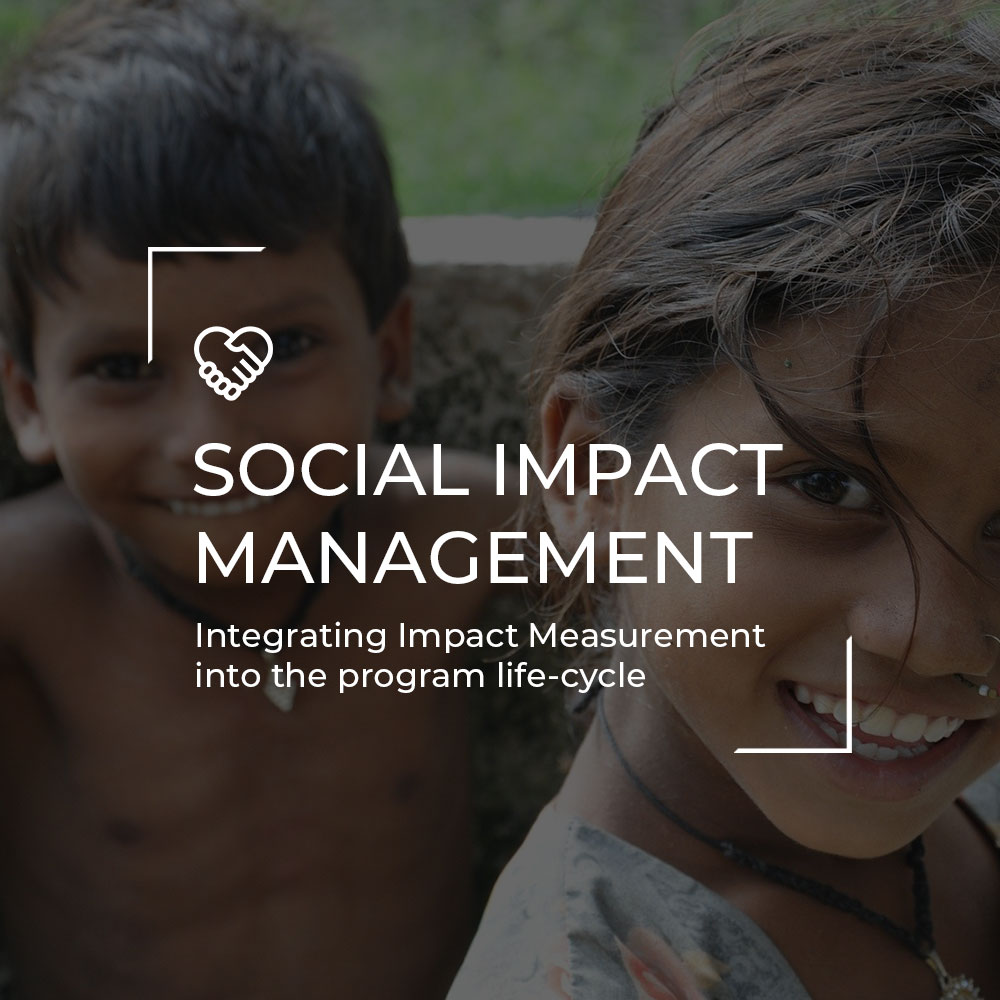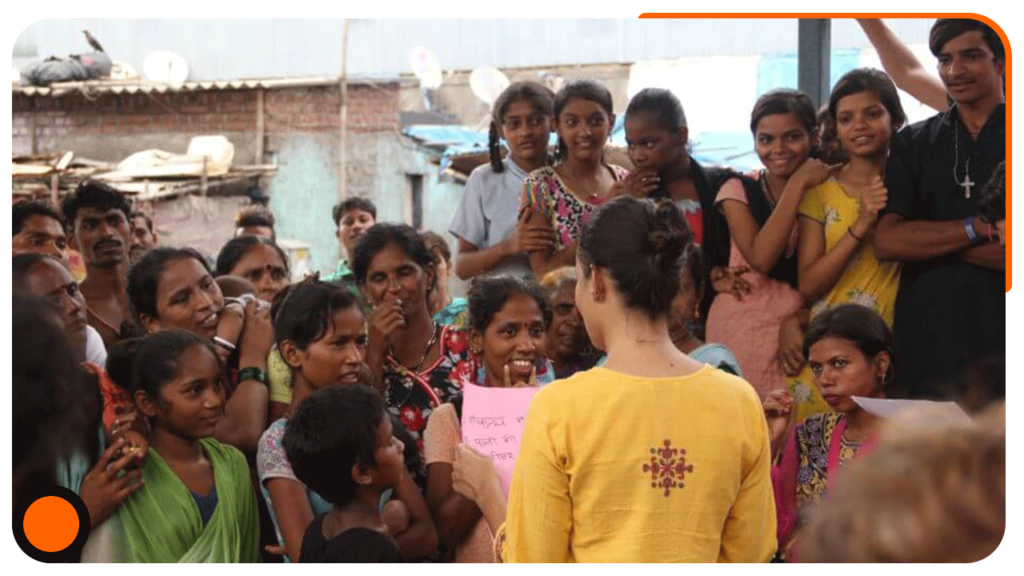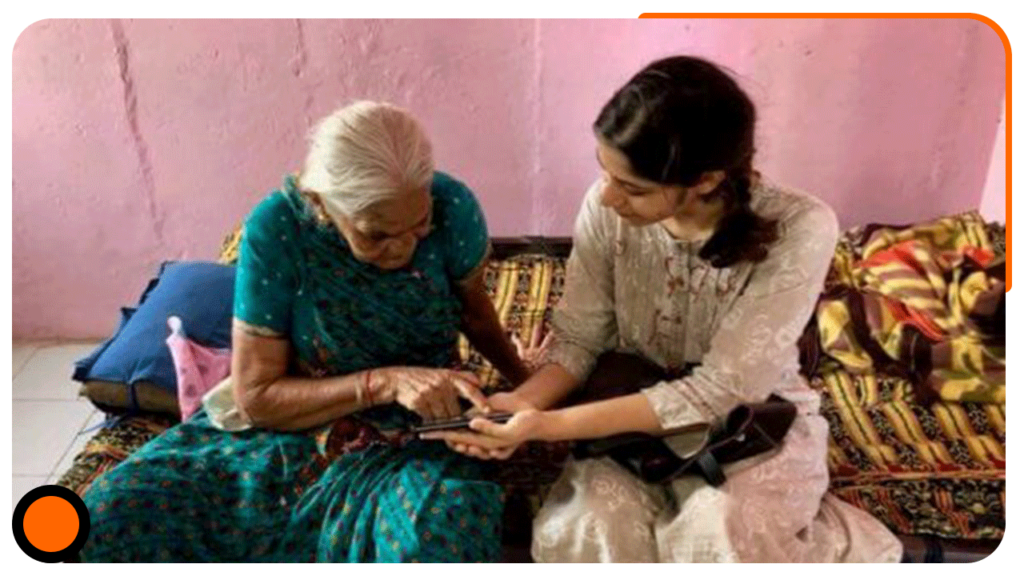

IMPACT STRATEGY
Investment strategies and social programmes that are evidence-based, result-oriented, and culturally relevant
IMPACT MANAGEMENT
A continuing function of systematic collection of data to determine the extent of progress and achievement of results from social investments
IMPACT MEASUREMENT
An objective assessment of impact investments, programme implementation, and impact outcomes to determine achievement of results
DEFINING SOCIAL IMPACT MANAGEMENT
DEFINING SOCIAL IMPACT MANAGEMENT
The essence of Social Impact Management lies in the belief that effective impact measurement is an ongoing process. It entails planning and management of social impact investments, spanning design, implementation, and measurement. All organisations contributing to social change, including Government bodies, Non-Government Organisations (NGOs), Corporate Social Responsibility (CSR) departments, and impact investors, can apply this approach to measure, manage, and optimize social impact.
Impact investments broadly serve three purposes:
- Act to avoid harm to stakeholders (managing risks)
- Benefit stakeholders (pursuing sustainable development goals)
- Contribute to solutions (addressing pressing social or environmental problems)
Social Impact Management is an ongoing practice of measuring and improving social investment outcomes to reduce negative impacts and increase positive impacts. Social Impact Management examines the implications of organisation strategies -evaluated in terms of their impact upon the quality of life of the communities and wider socio-economic repercussions in society- seeking to hone the potential of the social responsibility of business. The process manages social impacts throughout the whole project lifecycle while working as a management and learning tool for projects.
IMPORTANCE OF SOCIAL IMPACT MANAGEMENT
IMPORTANCE OF SOCIAL IMPACT MANAGEMENT
The Social Impact Management process adds value in a variety of ways. It provides a coherent framework for strategic planning and management, based on learning and accountability. It improves the effectiveness of social investments and service delivery by defining realistic expected results and targets. It estimates the social impacts that might occur during implementation and identifies proactive measures to respond to change across the lifecycle of projects. It enables the integration of lessons learned into management decisions and reporting performance. It encourages the formation of partnerships to attain shared outcomes.
Thus, social impact consulting enables social impact companies to consider ‘social impact’ throughout the project lifecycle to enable efficient mitigation and management of negative/ positive and intended/unintended impacts. The Social Impact Management Plan (SIMP) serves the following purposes:
- It provides a framework for the private sector to identify, assess and manage social impacts in their control and sphere of responsibility.
- It gives a deep contextual understanding of social issues, the target group, and expected impacts.
- It builds a database against which to monitor and assess a programme’s feasibility, progress, and effectiveness – during implementation and after it is complete.
While focusing on the importance of Corporate Social responsibility (CSR) activities, a SIMP adopts a holistic approach to social impact by examining the broader implications of organisational operations.
CHARACTERISTICS OF SOCIAL IMPACT MANAGEMENT
CHARACTERISTICS OF SOCIAL IMPACT MANAGEMENT
An organisation that has cultivated an evaluative culture emphasizes values of transparency, accountability, and continuous improvement. To demonstrate a strong commitment to evaluation, organisations should focus on building the internal capabilities of teams along with developing decision-making processes and structures. Impact evaluations should be planned and conducted in ways that enhance utilisation of findings, to inform decisions and improve performance.

A well-developed Theory of Change (ToC) ensures efficiency in the planning, implementation, and evaluation of development projects. A ToC is a visual representation of the change that social investments and programmes will make within the ecosystem they operate in. It illustrates the background and context of social investments, closely examining the assumptions and justifications to link impact to investment decisions while preparing the base for collecting and using data to understand and manage the social impact of those investments.

A Monitoring & Evaluation (M&E) framework should outline the scope and objectives of social investments and investment strategies while defining the data and information needs with the corresponding methods and sources of information. It should outline the roles and responsibilities of stakeholders in contributing to building the impact evaluation findings while putting in place a strategy for using the results. A good M&E framework ensures enhanced social performance, reduces social and environmental risks, and builds trust through better communication.

A data management system enables regular process (activity) monitoring to ensure the following:
- It tracks the use of inputs and resources and investment strategies.
- It measures programme progress.
- It helps to glean insights.
A data management system should also assess contexts in which social organisations and Corporate Social Responsibility (CSR) companies operate, and constantly document beneficiary perceptions, including their participation, treatment, access to resources, and their overall experience of change. Data systems will aid organisations to move towards a developed culture of statistical literacy, and adopt a more sophisticated approach to data production, use, analytics, visualisation, and communication.

ESSENTIALS OF AN IMPACT MANAGEMENT STRATEGY
ESSENTIALS OF AN IMPACT MANAGEMENT STRATEGY
The impact management services offered by 4th Wheel cater to the implementation of Government schemes and programmes, CSR activities, NGO programmes, and other relevant efforts. An Impact Management Strategy enables organisations to move from compliance with reporting and evaluation requirements to creating value from the process of impact evaluation. It takes cognisance of the social context within which social investments are made and lays the foundation for articulating a change theory model which accounts for external influences.
Stakeholder mapping is a collaborative impact management service. It involves research, debate, and discussion that draws from multiple perspectives to determine a list of stakeholders, their influences, and needs across the entire spectrum. Mapping helps to do the following:
- Identify relevant groups, organisations, and people
- Understand stakeholder perspectives and interests
- Visualize relationships to programme objectives
- Rank stakeholder relevance and identify related issues
This process results in an organisation ensuring good practice in social impact management by integrating stakeholder voices into decisions.

Needs assessments/baseline studies, aligned to the Sustainable Development Goals (SDGs), contribute in the following ways:
- They help to put in place the building blocks of an effective monitoring system.
- They contribute to improved governance and service delivery.
- They drive progress towards the shared objective of sustainable development.
Needs assessments/baseline studies build up the database against which an activity’s feasibility, progress, and effectiveness can be monitored and assessed– during programme implementation and after completion. This crucial impact management service maps specific indicators of programmes, under each SDG, based on the global indicator framework developed by the Inter-Agency and Expert Group on SDG Indicators.

Investors with credible impact investing practices share learnings where possible to enable others to learn from their experience as to what contributes to social and environmental benefits via a process evaluation. This exercise helps to learn from the implementation experience and identify gaps and successes, which can subsequently help sustain, strengthen and scale social investments. Areas of enquiry relate to implementation mechanisms, project management structures and systems, human resource development mechanisms, internal analysis, and reflection mechanisms.

Evaluation studies should provide rich quantitative and qualitative data to understand the impact performance of different enterprises and social investments against the Sustainable Development Goals (SDGs). Metrics that relate to the quantity and quality of effects should inform the findings. Data should be available in a year-on-year format for comparisons and be up to date. Data should involve contextual data analysis against targets with timelines and trends against benchmarks. The development of a counterfactual, using control or comparison groups to assess what changes might have happened otherwise, provides an evidence base for causal linkages.

